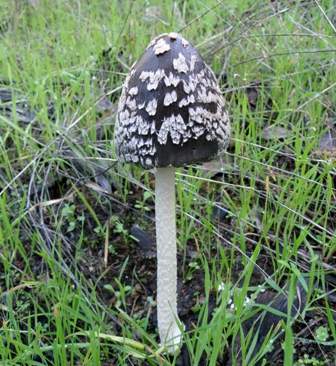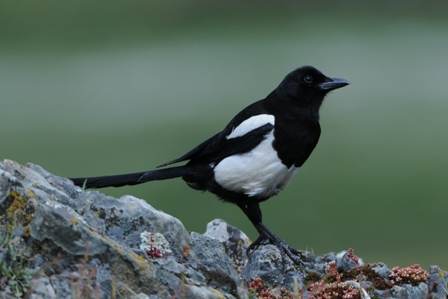At One with Nature - Two For Joy?
Sue Parker meets magpies - two with bad eating habits; the third seriously bad eating
In my youth in South Wales I was aware of the widely-held belief that magpies were bad omens, portents of evil and death. Life in the Algarve has taught me that it’s not necessarily such a black-and-white case. Like most superstitions, the origin is obscure. Some say that no amount (is it Noah, I meant?) of pleading could entice the malevolent magpie to go into the ark; others believe that magpies were evicted from the ark for being too noisy.
Magpies normally have one partner for life, so if you see one magpie on its own it’s quite possible that its mate has died. ‘One for Sorrow’, as the nursery rhyme goes…

Above: Azure Assasin - Iberian Magpie. Picture: Ray Tipper...
The name magpie comes from magot-pie, a corruption of Margot (Marguerite) pie. The ‘pie’ bit is easy to fathom; it means piebald or pied - usually white (skin, hair, scales or feathers) on a dark background. Shakespeare’s Macbeth says, ‘Augurs and understood relations have by magot-pies and choughs and rooks brought forth the secret'st man of blood.’ Argue the meaning we may, but the great bard was certainly not lauding these crows as bearers of glad tidings.
The Latin word for a magpie is pica, and Eurasian Magpies (they of pied attire) have the scientific name Pica pica. Infamous for digging holes with their beaks and storing choice titbits for later, these crows have a curious concept of food. Magpies will try to eat almost anything, stealing and stashing away buttons and beads, rings and things – indeed, the disorder where people eat paper, paint, earth and other inedible stuff is known as pica.

Above: The cap of a young Magpie Inkcap is covered in a white veil which, as the caps expands, tears into ragged fragments creating a ‘pied’ mushroom.
Fifteen years ago the azure-winged Algarve Magpie was an uncommon sight in our countryside; now there are ¼ million or more in the southwest of the Iberian Peninsula, many flocking in urban areas. (Other populations of Azure-winged Magpies Cyanopica cyanus occur thousands of miles away in eastern Asia, but genetic differences have been found that may justify the Iberian Magpie being given species status as Cyanopica cooki). These beautiful crows, similar in shape to the Eurasian Magpie but more slender, have wings and tails of gorgeous azure blue. They do not stick to a diet of acorns, berries, bugs and worms supplemented by baubles and buttons, however, and their habit of raiding songbirds’ nests of eggs and chicks is a concern leading some people to suggest that a cull is justified.
Like investments, populations can go down as well as up. Recent research has identified the Iberian Magpie as one of the bird species most threatened by climate change, with a predicted loss of between 50% and 95% in its range. Much will depend on its ability to find suitable new areas when its present habitat becomes inhospitable due to global warming.
There is yet another magpie in the Algarve, and - who knows? - maybe it could be drawn in to the conflict. The Magpie Inkcap Coprinopsis picacea (there’s that specific name again, this time extended to picacea, meaning ‘like a magpie’) is a pied black-and-white mushroom, but that final d is very important. As a pie it would most surely be ‘One for Sorrow’ since, although not quite the Lady Macbeth of the fungal kingdom, the Magpie Inkcap is a poisoner. This toxic toadstool can cause nasty stomach upsets, although usually nonfatal.
The Magpie Inkcap’s patterning is as superficial as that of its feathered namesake. Just as fine feathers make a fine bird, so also in the fungal kingdom is the beauty of this and many other patterned mushrooms quite literally only skin deep. A fine white skin or veil protects the young cap while it is underground, and as the cap expands the veil tears into fragments that separate like primeval continental plates to reveal the darker ocean of the cap surface. The result is a mushroom of monumental monochrome majesty.

Above: The Eurasian Magpie – a thief in the day with a taste for almost anything. Picture: Ray Tipper...
Magpie Inkcaps share the catholic taste of their avian namesakes: they spring up from caches of debris buried in riverside grassland during floods; they munch away at half-eaten hardwood in deciduous forests, and when there’s nothing else on the menu they will even get stuck in to rotting pine and eucalyptus trimmings. As with everything in the natural world, where would we be without them? These regal recyclers are usually solitarily, so stumbling across a pair of Magpie Inkcaps is certainly worthy of a ‘Two for Joy’ celebration, but, like Lady Macbeth, for beauty rather than bounty.

